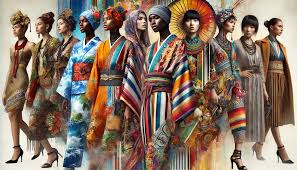Cultural Influence on Fashion: How Traditions and Societies Shape Style
Introduction
Fashion is not created in a vacuum; it is deeply intertwined with cultural influences. From historical traditions to contemporary global trends, culture plays a significant role in shaping the fashion world. This article explores how various cultural elements influence fashion, contributing to a rich and diverse sartorial landscape.

1. Historical Roots and Traditional Attire
Historical events and traditions have profoundly impacted fashion. Traditional garments, such as the kimono in Japan, the sari in India, and the kilt in Scotland, reflect cultural values, social structures, and historical narratives. These garments have influenced modern fashion by inspiring designers to incorporate traditional elements into contemporary designs.
2. The Role of Cultural Symbols and Motifs
Cultural symbols and motifs often find their way into fashion design, adding layers of meaning and context. Patterns, prints, and embroidery techniques derived from various cultures can evoke specific cultural narratives and aesthetics. For example, African prints and Japanese origami-inspired designs have become popular elements in global fashion, celebrating cultural diversity and heritage.
3. Fashion as a Reflection of Social Change
Fashion frequently mirrors social and political changes within a culture. For instance, the women’s liberation movement in the 1960s and 1970s influenced the rise of more casual and androgynous styles, such as pantsuits and miniskirts. Similarly, fashion has played a role in reflecting and challenging societal norms and attitudes towards gender, race, and identity.
4. Globalization and Cross-Cultural Influences
The globalization of fashion has led to an exchange of cultural influences across borders. Designers and brands are increasingly drawing inspiration from diverse cultures, leading to a fusion of styles that reflects a more interconnected world. While this cross-cultural exchange can enrich fashion, it also raises questions about cultural appropriation and the ethical implications of borrowing from other cultures.
5. The Impact of Cultural Icons and Media
Cultural icons and media have a significant influence on fashion trends. Celebrities, musicians, and film stars often become style icons, setting trends that resonate with their cultural backgrounds. The impact of these figures can be seen in how their personal styles influence public fashion tastes and industry trends.
6. Fashion and Cultural Identity
Fashion serves as a means of expressing cultural identity and pride. Individuals and communities use clothing to celebrate their heritage and convey their cultural values. Traditional garments and cultural attire often become symbols of identity and solidarity, particularly in multicultural societies where people seek to honor their roots.
7. Regional Fashion Trends and Local Craftsmanship
Regional fashion trends often reflect local customs, climate, and craftsmanship. For example, Scandinavian fashion emphasizes minimalism and functionality, while Mediterranean fashion highlights vibrant colors and lightweight fabrics. Local craftsmanship, such as hand-woven textiles and traditional dyeing techniques, also plays a crucial role in shaping regional fashion.
8. Challenges and Opportunities in Cultural Integration
Integrating cultural influences into fashion presents both opportunities and challenges. While it allows for a rich exchange of ideas and styles, it also raises concerns about cultural appropriation and exploitation. Fashion brands must navigate these complexities thoughtfully, respecting cultural heritage while promoting diversity and inclusivity.
Conclusion:
Cultural influences are an integral part of fashion, contributing to its richness and diversity. From traditional attire to contemporary global trends, culture shapes fashion in profound ways, reflecting and celebrating the many facets of human identity and experience. As fashion continues to evolve, embracing and honoring cultural influences will remain essential to creating a vibrant and inclusive industry.
Written By: Musaffa Mushtaq
